|
|
Post by DeadCanDanceR on Aug 20, 2022 9:12:05 GMT -5
Gorgeous Sunbeam!  |
|
oldirish33
Member
"All Jaguars run on Guinness!"
Posts: 3,352
|
Post by oldirish33 on Aug 21, 2022 11:39:26 GMT -5
Looks great! I've always liked the Alpine. Other than seeing them occasionally at British car shows, or on reruns of the movie It Takes a Thief, not a car I really had on my radar. Although heavy and underpowered, they did have decent lines and would make a nice touring car for a stylish, leisurely drive along the Riviera.  Thanks! See I used the photo from before I did the tail lights.  Must have been satisfying to finish the build. Will go well in your Stirling collection. Yes, I enjoyed it and as I say Stewart did the heavy lifting on this kit before he passed it on. Not a car I would have originally chosen for my Moss collection, but have been taken over by its charm. Gorgeous Sunbeam!  Thanks Julio! |
|
oldirish33
Member
"All Jaguars run on Guinness!"
Posts: 3,352
|
Post by oldirish33 on Aug 27, 2022 13:59:05 GMT -5
Topless Ford - I have had this old Bizarre model on my wish list for sometime as my interest in the Targa Florio intensified over the last couple of years. One finally came up for sale at what I thought was a realistic price, so I have added it to my GT40 and TF collections. As with most Targa's, the one in 1965 was not without some great backstories and the tale of this car is interwoven into the great fabric of the Targa Florio. 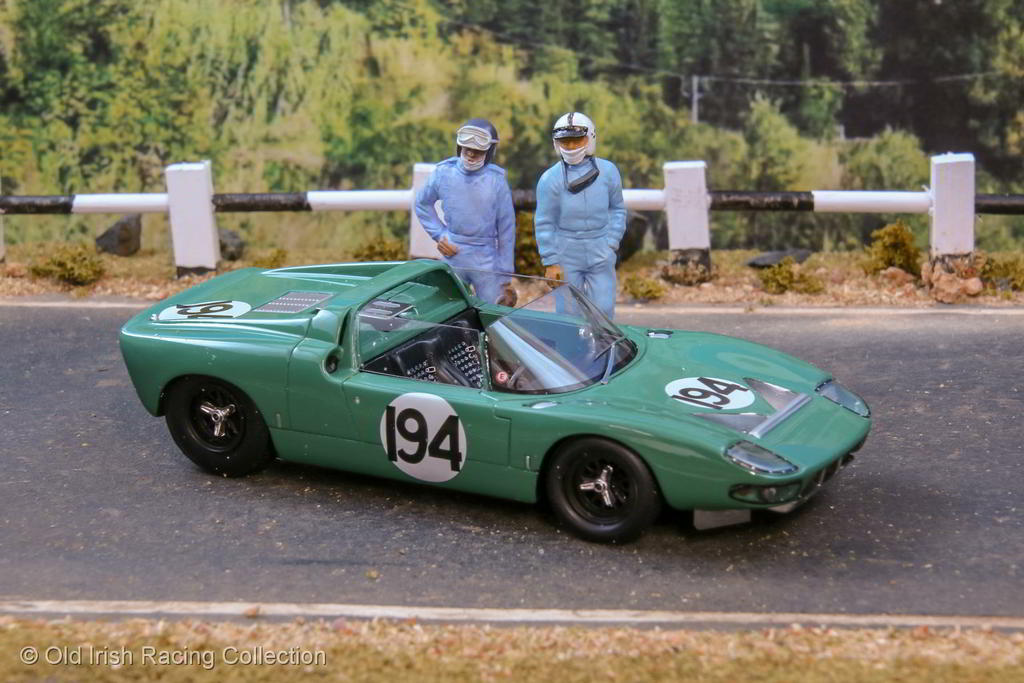 As one of the twelve GT40 prototypes built, Chassis #GT/111 was one of the four GT40 roadsters. The car was built and maintained by Ford Advanced Vehicles and was taken to the Le Mans test in April 1965. Not as fast as the GT40 coupes, it was decided instead that the Targa Florio in May would be a better venue for the open car and was shipped off to Sicily with Bob Bondurant and Sir John Whitmore assigned the driving duties. It was painted Linden Green in a nod to FAV which was base in Slough. For the 49th Targa Florio, the lone Ford prototype entry was up against solid opposition from both Ferrari and Porsche, with the Chaparral 2F thrown in for good measure. Ferrari brough three powerful 275P/2 works entries and Porsche a trio of 904s. 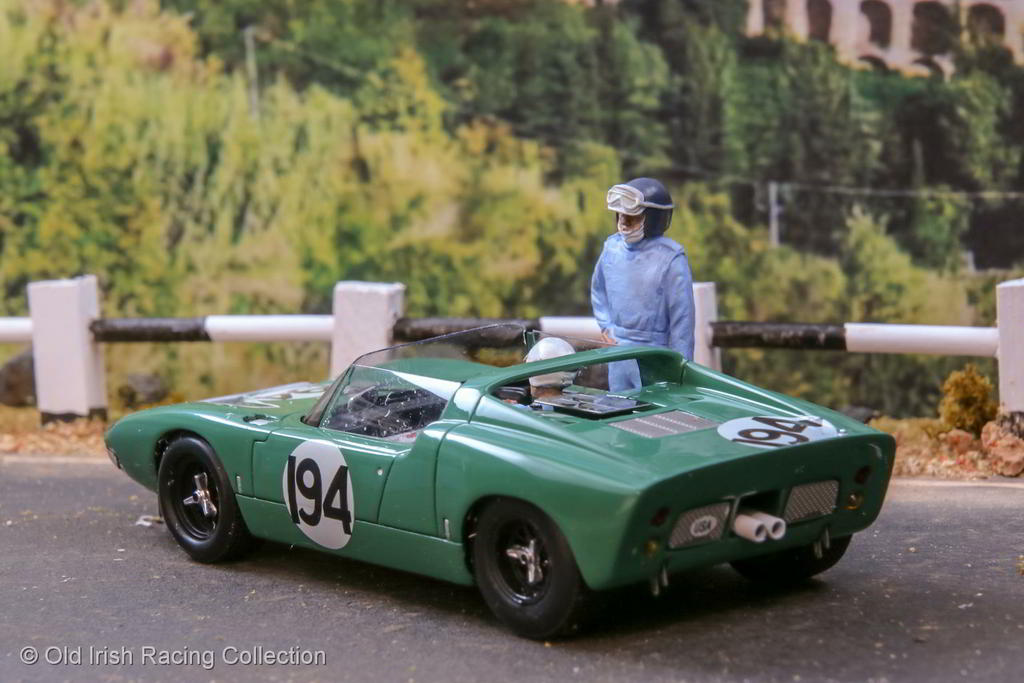 Ferrari were the odds-on favorite to win with their 3.3L V12 powered cars, primarily due to the duo of Vaccarella and Bandini, with the former being the local hero. Not to be outdone, Porsche brought two 2.0L eight-cylinder cars on the 904 chassis (904/8), a coupe and roadster. Typical of the Targa, the weather was hot and dry and speeds were expected to be high on the ten laps of the 44.7 mile (72Km) circuit. As expected, Ferrari dominated the early laps, with the GT40 running as high as third despite the car only running on seven cylinders early on. Then Whitmore lost the left front wheel on the long sea-level straight towards start/finish. He was able to fit the spare and with the help of a local policeman get back the wheel knockoff to get back to the pits. 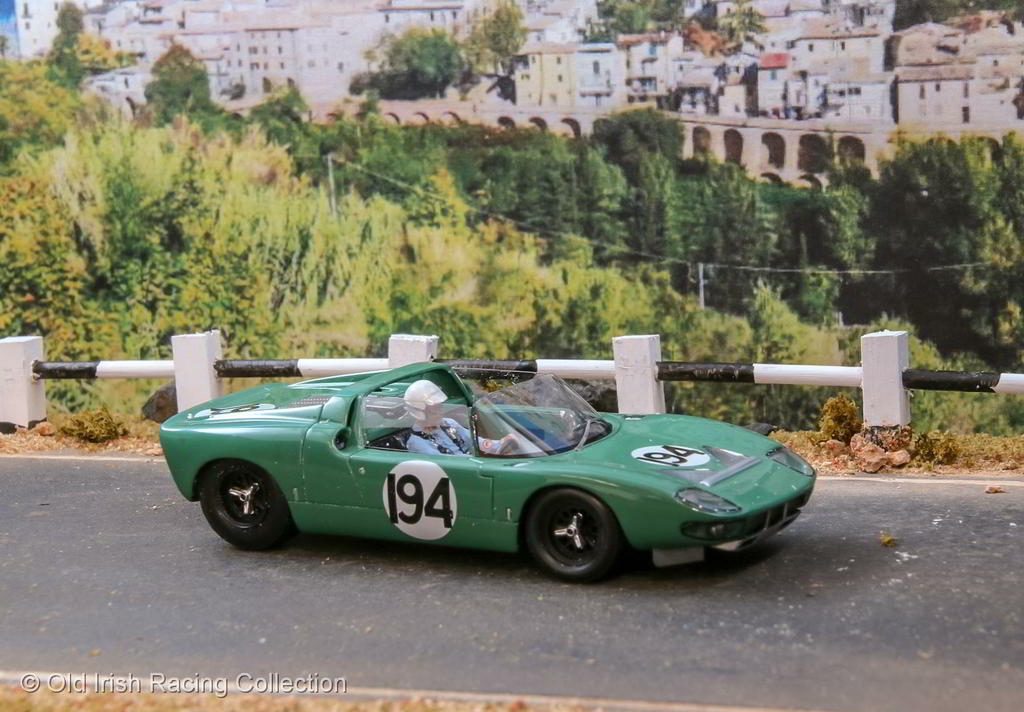 As the weather got hotter and hotter and attrition was taking its toll, the open Ford was making up lost time and positions when Bondurant had his own bad luck. On the last lap he dropped a wheel off the road after hitting some gravel, causing him to lose control of the car which hit a wall and then a water trough before coming to a stop. The damage put the car out of the race which was won by Vaccarella in the Ferrari, with Porsche taking the next four places. Sent back to FAV, it was scavenged for parts before eventually being ordered scrapped in 1966. The scrap merchant kept the chassis in a London lock-up for forty years before it was sold and eventually restored in its original Targa condition. One of two surviving GT40 roadsters. 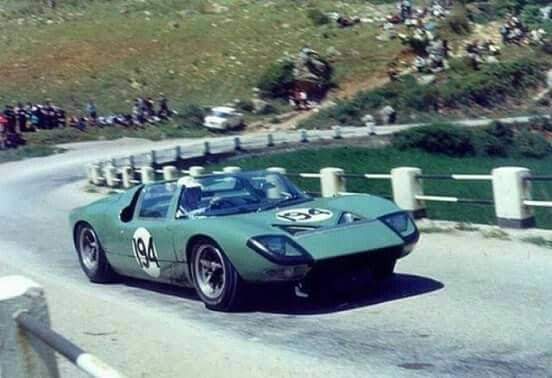
|
|
|
|
Post by Tom on Aug 27, 2022 15:25:27 GMT -5
That is incredibly cool!
|
|
|
|
Post by WallOfCars on Aug 27, 2022 15:38:36 GMT -5
Lovely period photos & storytelling Jerry. To be honest, without my glasses on and half-way across the room your model from the rear 3/4 view resembled a Saab Sonett. Up for an eye exam next week!
|
|
|
|
Post by Alfaholic on Aug 28, 2022 1:54:43 GMT -5
I see the Saab Sonnet resemblance as well, but it is very much a GT40. Wonderful.
|
|
|
|
Post by reeft1 on Aug 28, 2022 10:18:35 GMT -5
I have that - great model
|
|
oldirish33
Member
"All Jaguars run on Guinness!"
Posts: 3,352
|
Post by oldirish33 on Aug 28, 2022 13:24:35 GMT -5
Glad you like it Tom, the roadsters did add some spice to the GT40 lineup. Lovely period photos & storytelling Jerry. To be honest, without my glasses on and half-way across the room your model from the rear 3/4 view resembled a Saab Sonett. Up for an eye exam next week! I see the Saab Sonnet resemblance as well, but it is very much a GT40. Wonderful. Thanks Martin and Brooks! It is interesting the resemblance, but I think many cars with Kamm tails and sweeping haunches resembled each other at the time from a 3/4 look. I think its coincidental. However, the Sonnet II was released in 1966 and was designed as a race car. I suppose its possible that Saab was influenced by the Ford design. I have that - great model Yes, surprised its not one Spark has re-released, but give them time. More Moss - The Pescara Circuit epitomizes the Italian love for auto racing and racing through villages and the countryside. In the vein of the Mille Miglia and Targa Florio, the Pescara course had long straight sections, combined with tricky mountain curves. Pescara holds the record as the longest F1 circuit. At a length of 16 miles (26 Km), it was roughly triangle shaped with two long straight sections tied together with a twisty hill section. Its longest straight was just shorter than the Mulsanne Straight at Le Mans, so cars ran flat out for a long time and distance. Truly a test for both man and machine. In 1957, it was a Round of the FIA F1 Championship. Vanwall VW5 - Pescara GP, 1957 - Stirling Moss, Winner - Model by Spark Tony Vandervell who owned the Thinwall Bearings company, was an early supporter of BRM. However, he grew impatient with BRM and set out to build his own Grand Prix car. His Vanwall team developed a 2.5L four-cylinder fuel-injected engine using Norton motorcycle head technology with Rolls Royce industrial engine technology for the bottom-end capable of 290 BHP. Colin Chapman and Frank Costin were engaged to design the cars suspension and body. The car impressed Stirling Moss who drove the car part time in 1956 when his contract with Maserati allowed. For 1957, Moss was employed full-time, and the car further refined into the VW5. 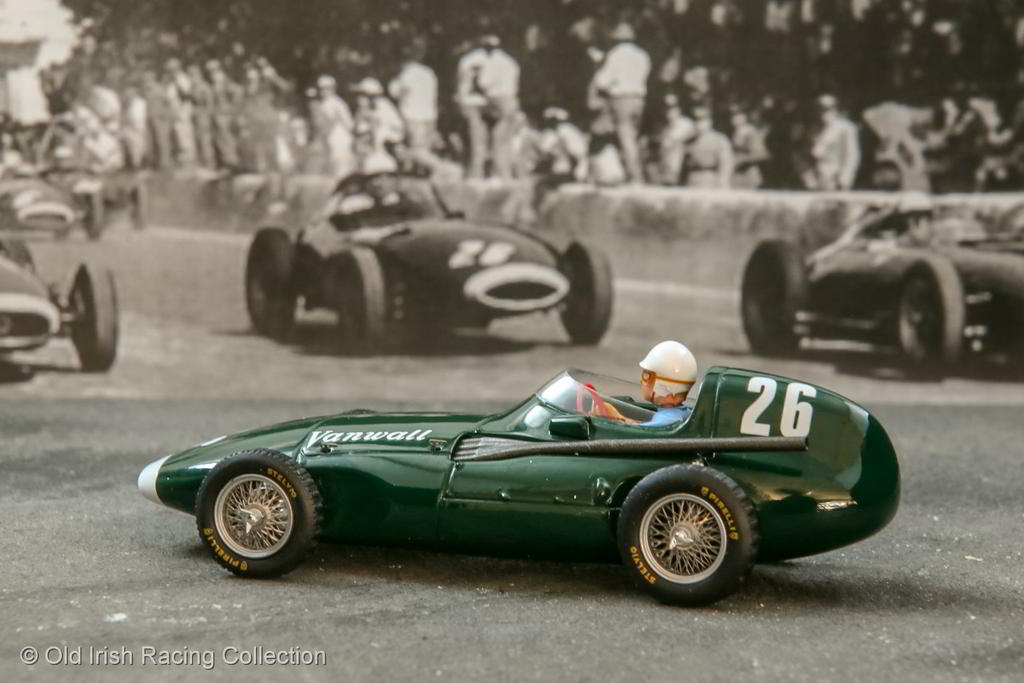 Moss crashed the car at Monaco when his front brakes failed, which cost him two races due to his injuries, which cost him the Championship. Back for the British GP, Moss was the first British driver in a British car to win his home GP. With the Pescara GP next, Moss was pleased that the Vanwalls aerodynamics worked well on the long straights of the 16 mile (25.8 Km) Italian Circuit. After a passing Musso in a Ferrari on the second lap, he led comfortably the entire race, beating Fangio in his Maserati by three minutes. He won the final GP at Monza in the Vanwall, finishing second in the Drivers Championship behind Fangio in 1957. He would be back with Vanwell in 1958 and another close Championship race. 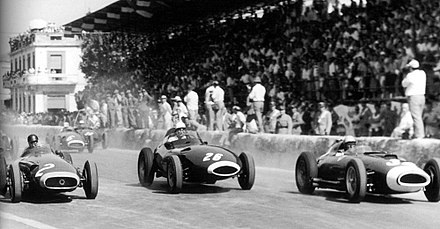 The Pescara GP was added to the 1957 F1 season with the cancellation of the Dutch and Belgian GPs due to the tragedy on the Mille Miglia. Moss rented a Fiat 1100 to travel the 3 ½ hours from Rome to the Pescara circuit, arriving in time to do three practice laps. Qualifying 2nd behind Fangio and Musso he led the race from the second lap and won handily. On his drive back to Rome, the Fiat blew a head gasket and he had to take a taxi in a race to make his flight back to London. He got to the airport, only to discover his flight had been cancelled. Far from today when drivers are whisked to and from the circuit by helicopter and then by private jet home. However, much like today, you cant depend on the airline. Another nice 1950's F1 effort by Spark and add to my Moss and F1 collections. For once, they didn't use a metallic based paint!  |
|
|
|
Post by Alfaholic on Aug 28, 2022 21:41:56 GMT -5
That is indeed a wonderful model and a must for your collection. If t was red it would be perfect  . |
|
|
|
Post by jager on Aug 29, 2022 9:48:31 GMT -5
Love the GT40 Jerry - easy to see why you were drawn to it. As an earlier Bizarre release, it will be interesting to see if Spark re-release it given they done so many of the Bizarre GT40's.
Nothing wrong with the Vanwall either. I found myself in Pescara for day on a business trip about a decade ago, but never found anything motorsport related in the short time I was there.
|
|
|
|
Post by Tom on Aug 29, 2022 15:51:20 GMT -5
That is fantastic!
|
|
oldirish33
Member
"All Jaguars run on Guinness!"
Posts: 3,352
|
Post by oldirish33 on Sept 12, 2022 17:24:12 GMT -5
Italian Novella - Like many Italian race cars that have through the decades passed through the hands of many owners and undergone body and engine changes, the car that inspired this model is no different. Also like many Italian cars, its history is often disjointed and has to be pieced together from many sources, hoping in the end that you got the majority of it right. This model was offered by Grand Prix Models in their rarities section for some time as a Alfa Romeo 1900 SS Conrero, Conrero being a famous Alfa tuner and car builder. I hemmed and hawed about it, but finally decided I liked it enough to say yes. When I received it, I started to do research but could find no Conrero connection. I can understand GPM's error, because it is labeled as a 1952 Alfa Romeo 1900 Barchetta by its manufacturer. (also on the web) Both were wrong. Instead, I found out it was a Ermini, a small specialist Italian make many may not have heard of. After a fair bit of research over several different sources including the Ermini company itself, I think I have put its disjointed, but interesting history together correctly. 1955 Ermini 357 Scaglietti Barchetta - Jolly ModelPasquale Ermini was one of the many small car builders and tuners that existed in Italy just after WWII. Prior to the war, Ermini had been a successful race car driver and mechanic. The cars that Ermini built were very successful on Italian racetracks and hill climbs, taking class wins at the Mille Miglia as an example of their success. Over the course of twelve years, Ermini built thirty-seven cars. Most were powered by 1000cc Fiat engines, which featured Ermini DOHC heads, and were built on a Gilco designed tubular steel chassis. Perhaps his most beautiful car was the Scaglietti bodied 357, which featured 1.1L, 1.5L and a proposed 2.0L engine. A car that drew the ire of Enzo Ferrari as a serious rival. 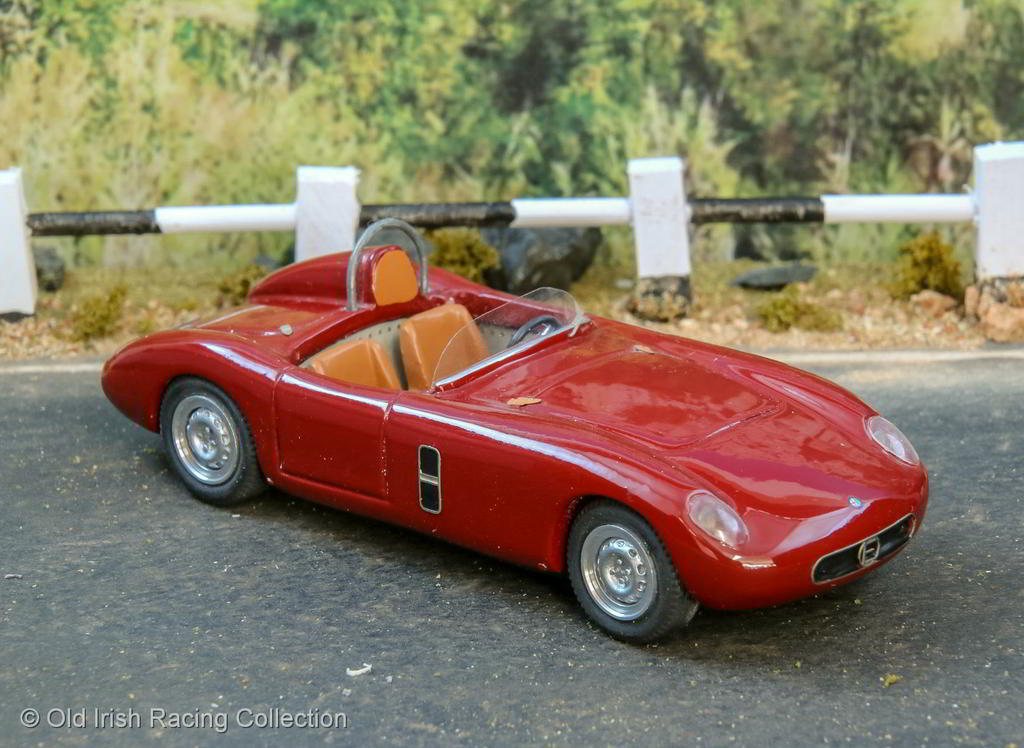 With the 357 (which resembles a Ferrari 750 Monza), Ferrari saw a threat to his own cars and ordered Scaglietti to stop working on Erminis cars after only three had been built in 1955. Two others were completed to the original design by another coachbuilder not as indebted as Scaglietti was to Ferrari. This car is one of the three Scaglietti cars and originally had a 1.5L Ermini engine. Its first owner Enrico Manzini is believed to have driven it on the 1955 Mille Miglia, but failed to finish. He sold the car to its next owner Tony Pompeo, who exported it to the USA and subsequently sold it to SCCA racer Jim Orr. Between Orr and its next two owners it was raced on the West Coast of the US, being wrecked in 1957, badly damaging the alloy bodywork. 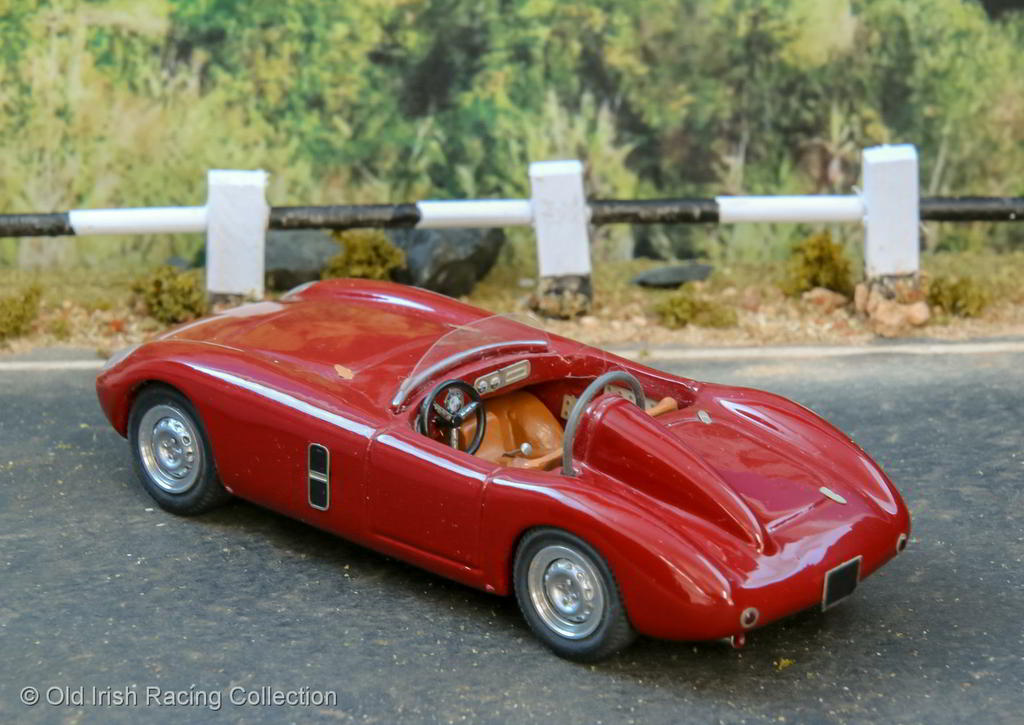 Repair of the car was entrusted to Bill Devin of Devin sports car fame. Devin had used this car as the template for his fiberglass Devin sports racer while owned by Jim Orr. While being repaired in 1957, it had a Devin SS body installed and the engine converted to a Alfa Romeo 2.0L four from a Alfa Romeo 1900. It was also given a DeDion rear end with inboard drum brakes. In the late 1980’s, the car was restored and given a replica of its original alloy body. It was raced for several years in vintage events, including the Monterey Historics in 1993, before being sold to a collector in Columbia, who subsequently raced it there. It has now been brought back to the USA, ready for its next chapter. 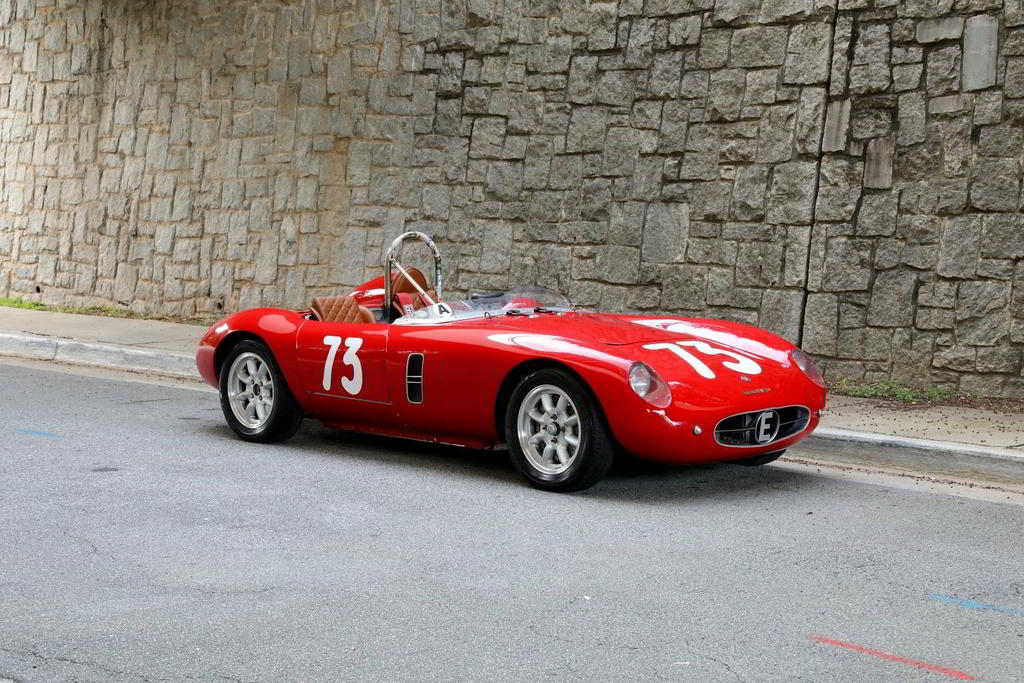 The car today has been tuned for street use. At what exact period in its life Jolly Model chose to model the car is not known for certain, its part of the yet unsolved mystery. It was converted at one point from wire to solid (steel wheels) and the wheels on the model look to be Alfa wheels. I would guess this occurred at the time it was given the de Dion rear end, but its only a guess. While at first I was disappointed it was not an Alfa special, I have found its story compelling and of much greater interest than I originally thought. 
|
|
|
|
Post by WallOfCars on Sept 12, 2022 18:19:02 GMT -5
Another great tale that weaves into it the names of some known and not so know names Jerry. The 1:1 is particularly attractive in that light and angle. I'm guessing those are Minilite or similar rims? They suit it well! Such a simple shape stem to stern, yet so lovely in the details for an overall winning look!
|
|
|
|
Post by Alfaholic on Sept 12, 2022 20:54:26 GMT -5
Your first paragraph pretty much mirrors my life Jerry (or at least the 1:43 research part). Delving into these stories is both frustrating and fun, but at the end you have some useful(?) information - even if at my age I have to remove some other non-important information from the hard-drive in my head  . The model is instantly recognisable as a "Jolly", with all the good and bad that comes with that - I have spent many hours trying to work out exactly what their models are of, you can't always trust what is on the box! I would like to go down the rabbit hole of these smaller marques, but fear that my already muddled Alfa brain would not be able to cope with it. Ah, and I love the model of course  . |
|
|
|
Post by Tom on Sept 12, 2022 23:35:24 GMT -5
That is fantastic! Love the results of your research, what a rarity. Great back story, great model.
|
|